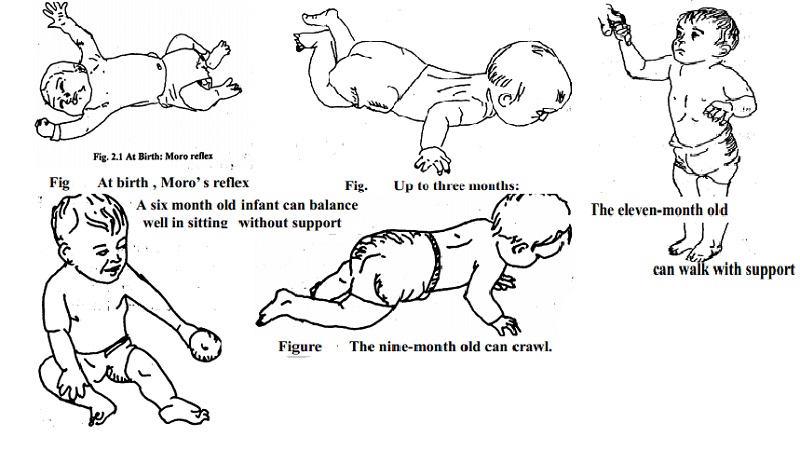Chapter: 11th 12th std standard Class Nursing Health Care Hospital Hygiene Higher secondary school College Notes
Physical growth and development from birth to one year

Physical
growth and development from birth to one year:
1. At Birth:
At birth, infants' posture is of generalised flexion. When
newborn babies lie in the prone position, legs are drawn up and they turn the
head on one side. When pulled to sit, the head lags behind. Hands are clenched
and the grasp reflex is strong.
Moro's reflex, tonic neck, and crossed extensor reflexes are
present. Deglutition reflex (rooting, sucking, and swallowing) is present.
Dolls' eyes are seen up to two weeks. Pupillary reaction present.
2. Up to three months:
By three months, flexion is reduced. In prone position, the
baby can lift the head to 90 o (Fig.4.3 ). By the age of four weeks, walking,
placing, and cross reflexes disappear, and Moro's and grasp reflexes are
absent. Infants may follow the moving object through 180 o .
They turn the head toward the sound. They can grasp the toy
but they lack a firm holding. They look interested in the surroundings, give a
social smile, and recognize the mother. Babies show displeasure by an
expression or a cry.
3. From
three to six months:
During this period, infants adopt
symmetrical posture, in supine. When lying in prone, infants try to raise the
chest off in a vertical axis and increase the extension of legs. By six months,
infants roll over from prone to supine and can sit with or without a support.
(Fig.4.4).
Infants hold object with palms, grasp, and take it to the
mouth for exploration. Infants recognise parents' voice. Around the six months,
the teeth's eruption may start, first with lower incisors. Infants get excited
at the sight of food and poise mouth for feeding. During this period, the
infants laugh aloud and coo, smile at a mirror image, and show pleasure and
displeasure.
4. From
six to nine months:
During this period, infants can turn from supine to prone,
can sit without support, and attempt to creep and crawl. By nine months, they
can stand with a support. They play with the foot and learn to put their foot
in the mouth. They can transfer a toy from one hand to the other and then, to
the mouth. Infants respond to their own
name. They are frightened of strangers (turns away and cry,
and stop crying when held by the mother). They love repetitive games.
5. From
nine to twelve months:
During this period, infants can sit without support and make
movements. They walk with a support and cruise all round. They release an
object to another-person, on request. They try to feed themselves and can drink
from a cup. They drop toys deliberately. They make postural adjustments.
Infants can speak two words with the meaning.
They develop an ability to show emotions, such as, fear,
anger, jealousy, and anxiety and they can draw attention. They smile at their
image. By one year, six to eight teeth may appear.
6. Sense
of trust:
The sense of trust may be
strengthened or weakened by the positive and negative experiences,
respectively.
If the mother provides a loving,
warm, and consistent care, the infant develops a trust in her. With the
maternal-infant attachment, the infant develops the trust and feels secure. A
mother substitute also, should try to provide experiences that develop trust.
The sense of trust is accomplished
with experiences and events which infants are repeatedly receiving when they are
hungry, uncomfortable, cold, and lonely. If infants get attention in time,
develop a trust as an integral part of their development. Each close contact
with the infants is an opportunity for them to experience the pleasure of
intimacy. While caring for infants in health and illness, one must understand
their basic needs.
Need for warmth and comfort:
If infants are held during the
feeding they can experience warmth, comfort, security, and pleasure along with
the nutrition. The attitude can be expressed in the voice, touch, and handling
the infant.
Need for Sucking:
During the first year, infants get pleasure by sucking. They
put every thing in the mouth and enjoy. This need should be satisfied by
providing breast feeding/bottle feeding and washable safe toys. Gradually,
infants' need for sucking decreases over the time.
Need for sensory stimulation:
Infant receive sensory experiences right from the birth, by
the contact with the mother's body and touch of the hands of various people who
take care of them. They see and hear many things.
Thus, they communicate with the environment. Gradually they
try to explore their body. They need a stimulation by change in the
environment, by change of position, by contact with various textures, by sights
and sound. They should be gradually introduced to a wider and more varied
experiences and activities, through various sensory organs.
The nurse needs to understand the above needs of infants
when they are separated from their family and especially from the mother, during
hospitalisation. Especially in the intensive care unit, nurses must try to
fulfill these needs through the mother and other modes.
Related Topics